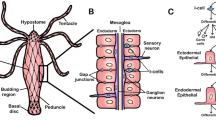Summary
1. Extra- and intracellular recordings from single units in the magnocellular mesencephalic nucleus (MMN) of the torus semicircularis, related to the fast electrosensory system are reported for the weakly electric fish Gymnotus carapo (Gymnotidae). 2. The non-spontaneously active units responded with single action potentials to the electric organ discharge (EOD) and to artificial electrical pulses with a very short latency of 0.8–1.5 ms. This strongly suggests, in agreement with morphological data, that transmission takes place through electrical synapses. 3. The dynamic range (probability and latency of the single action potential) of the response is extremely narrow and about the same as found in the relevant electrosensory fibres. Intracellular stimulation gives the same response characteristics and dynamic range. 4. The recovery of the response was studied in detail using different stimulus combinations of double pulses at varying delays. Under all conditions, the recovery period to evoke a test response after a conditioning stimulus and response increased in length with the strength of the conditioning stimulus. Inversely, the conditioning stimulus to prevent the unit from firing again had to be stronger as the delay between the two stimuli was increased. 5. Since there is no evidence of neural inhibition causing the long lasting and graded recovery characteristics for MMN units, an attempt was made to explain the findings by classical neurophysiological considerations adapted for electrical synaptic transmission (“current sink” theory). 6. This neural mechanism means that, if at all, the relatively weaker stimulus is not responded to, which protects the fish from being jammed by external pulses of physiological amplitude. In contrast, very strong foreign pulses can completely abolish responses to own EODs especially when timed appropriately. Both effects are discussed in view of their significance for the fish's electrosensory system and communication.
Similar content being viewed by others
References
Bennett, M.V.L.: Electric organs. Electroreception. In: Fish Physiology (eds. W.S. Hoar, D.J. Randall). New York: Academic Press 1971
Bennett, M.V.L.: A comparison of electrically and chemically mediated transmission. In: structure and function of synapses (eds. G.D. Pappas, D.P. Purpura), pp. 221–256. New York: Raven Press 1972
Bennett, M.V.L., Grundfest, H.: Electrophysiology of electric organs in Gymnotus carapo. J. gen. Physiol. 42, 1067–1104 (1959)
Bullock, T.H.: Species differences in effect of electroreceptive input on electric organ pacemakers and other aspects of behaviour in electric fish. Brain Behav. Evol. 2, 85–118 (1969)
Hagiwara, S., Morita, K.: Coding mechanisms of electroreceptor fibers in some electric fish. J. Neurophysiol. 26, 551–567 (1963)
Heiligenberg, W.: Electrolocation and jamming avoidance in the Mormyrid fish, Brienomyrus, J. comp. Physiol. 109, 357–372 (1976)
Kramer, B.: Electric organ discharge interaction during interspecific agonistic behaviour in freely swimming mormyrid fish. J. comp. Physiol. 93, 203–235 (1974)
Kramer, B., Bauer, R.: Agonistic behaviour and electric signalling in a Mormyrid fish, Gnathonemus petersii. Behav. Ecol. Sociobiol. 1, 45–61 (1976)
Lissmann, H.W.: On the function and evolution of electric organs in fish. J. exp. Biol. 35, 156–191 (1958)
Réthelyi, M, Szabo, T.: A particular nucleus in the mesencephalon of a weakly electric fish: Gymnotus carapo (Gymnotidae). Exp. Brain Res. 17, 229–241 (1973)
Russell, C.J., Mayers, J.P., Bell, C.C.: The echo response in Gnathonemus petersii (Mormyrides). J. comp. Physiol. 92, 181–200 (1974)
Scheich, H., Bullock, T.H.: The detection of electric fields from electric organs. In: Handbook of Sensory Physiology, Vol. III/3 (ed. A. Fessard), Berlin-Heidelberg-New York: Springer 1974
Scheich, H., Bullock, T.H., Hamstra, R.H., Jr.: Coding properties of two classes of afferent nerve fibers: High-frequency electroreceptors in the electric fish, Eigenmannia. J. Neurophysiol. 36, 39–60 (1973)
Schlegel, P.: Perception of objects in weakly electric fish, Gymnotus carapo, as studied in recordings from rhombencephalic neurons. Exp. Brain Res. 18, 340–354 (1973)
Schlegel, P.: Elektroortung bei schwach elektrischen Fischen: Verzerrungen des elektrischen Feldes von Gymnotus carapo und Gnathonemus petersii durch Gegenstände und ihre Wirkung auf afferente Aktivitäten. Biol. Cybernetics 20, 197–212 (1975)
Sotelo, C., Réthelyi, M., Szabo, T.: Morphological correlates for electrotonic transmission in the magnocellular mesencephalic nucleus of the weakly electric fish Gymnotus carapo. J. Neurocytol. 4, 587–607 (1975)
Suga, N.: Coding in tuberous and ampullary organs of a gymnotid electric fish. J. comp. Neurol. 131, 437–451 (1967)
Szabo, T.: Activity of peripheral and central neurons involved in electroreception. In: lateral line detectors (ed. P. Cahn). Bloomington: Indiana University Press 1967
Szabo, T.: Morphologische und funktionelle Aspekte bei Elektrorezeptoren. Verh. Dtsch. Zool. Ges. 10, 141–148 (1970)
Szabo, T., Fessard, A.: Physiology of electroreceptors. In: Handbook of Sensory Physiology, Vol. III/3 (ed. A. Fessard), Berlin-Heidelberg-New York: Springer 1974
Szabo, T., Sakata, H., Ravaille, M.: An electrotonically coupled pathway in the central nervous system of some teleost fish, Gymnotidae and Mormyridae. Brain Res. 95, 459–474 (1975)
Westby, G.W.M.: Assessment of the signal value of certain discharge patterns in the electric fish, Gymnotus carapo by means of playback. J. comp. Physiol. 92, 327–341 (1974)
Westby, G.W. M.: Has the latency dependant response of Gymnotus carapo to discharge-triggered stimuli a bearing on electric fish communication? J. comp. Physiol. 96, 307–341 (1975)
Zipser, B.: The electrosensory system of mormyrids. Ph. D. Thesis, Albert Einstein College of Medicine. New York: Yeshiva University 1971
Zipser, B., Bennett, M.V.L.: Interaction of electrosensory and electromotor signals in lateral line lobe of a mormyrid fish. J. Neurophysiol. 39, 713–721 (1976)
Author information
Authors and Affiliations
Rights and permissions
About this article
Cite this article
Schlegel, P.A. Electroreceptive single units in the mesencephalic magnocellular nucleus of the weakly electric fish gymnotus carapo. Exp Brain Res 29, 201–218 (1977). https://doi.org/10.1007/BF00237042
Issue Date:
DOI: https://doi.org/10.1007/BF00237042




